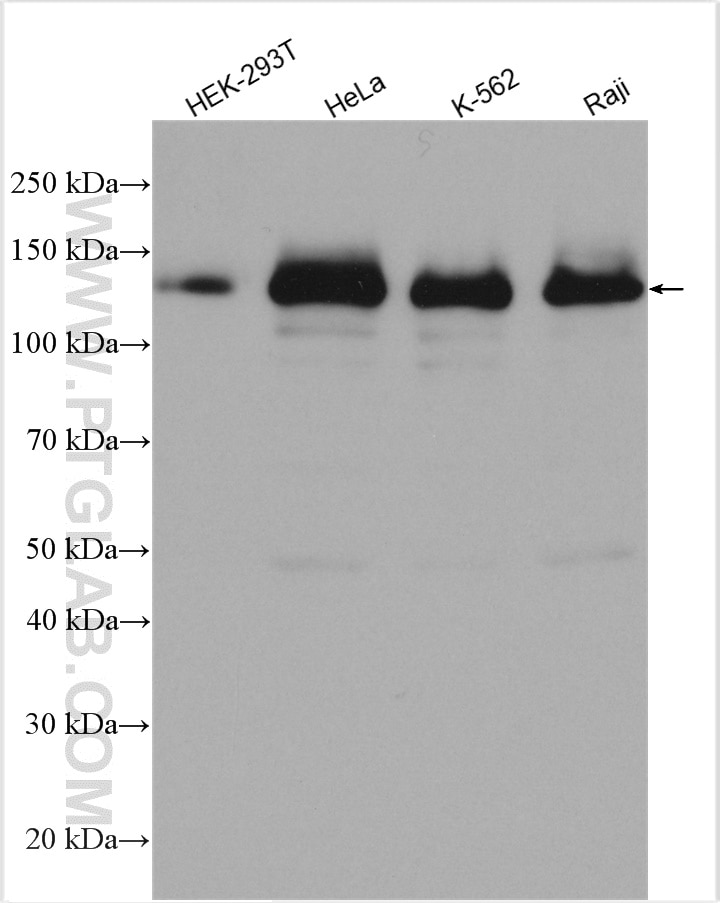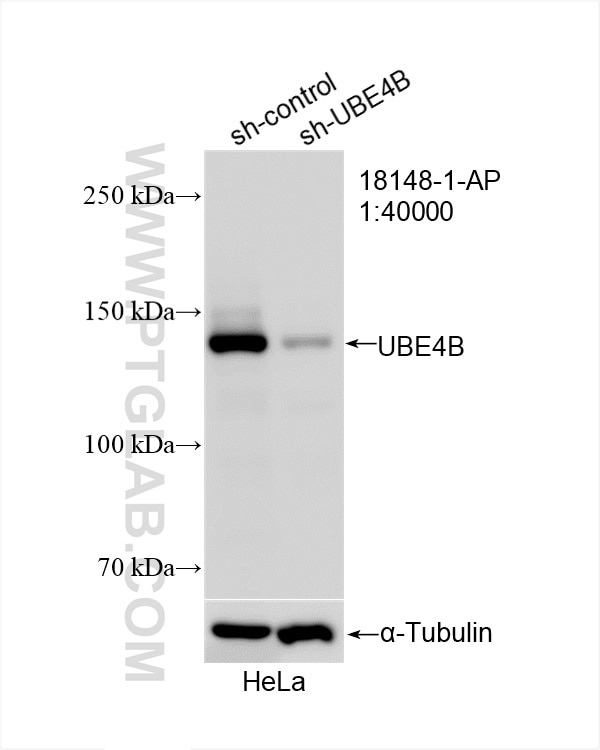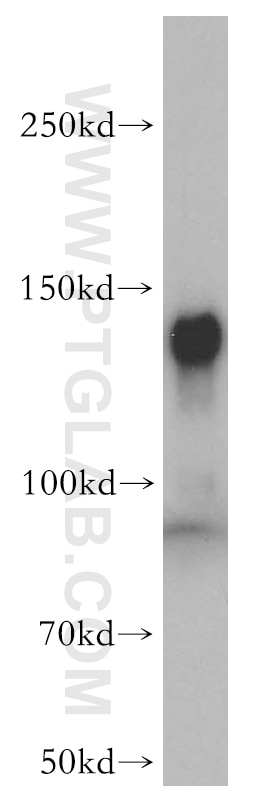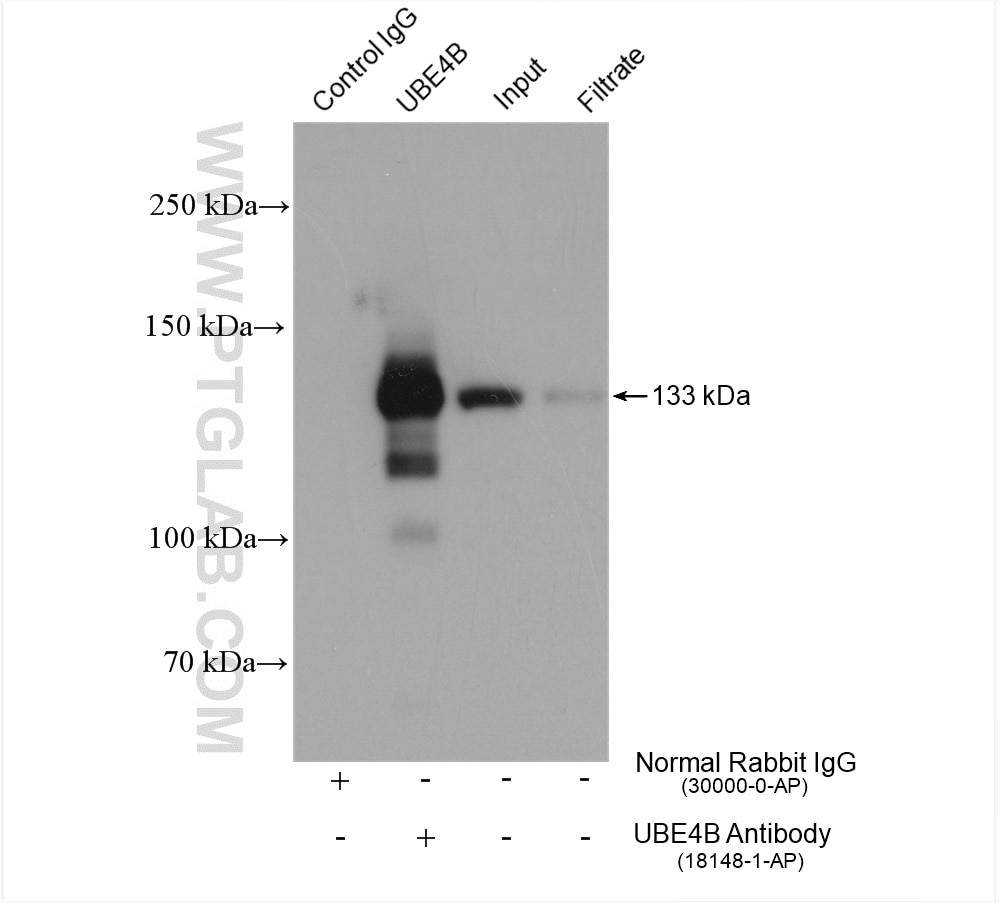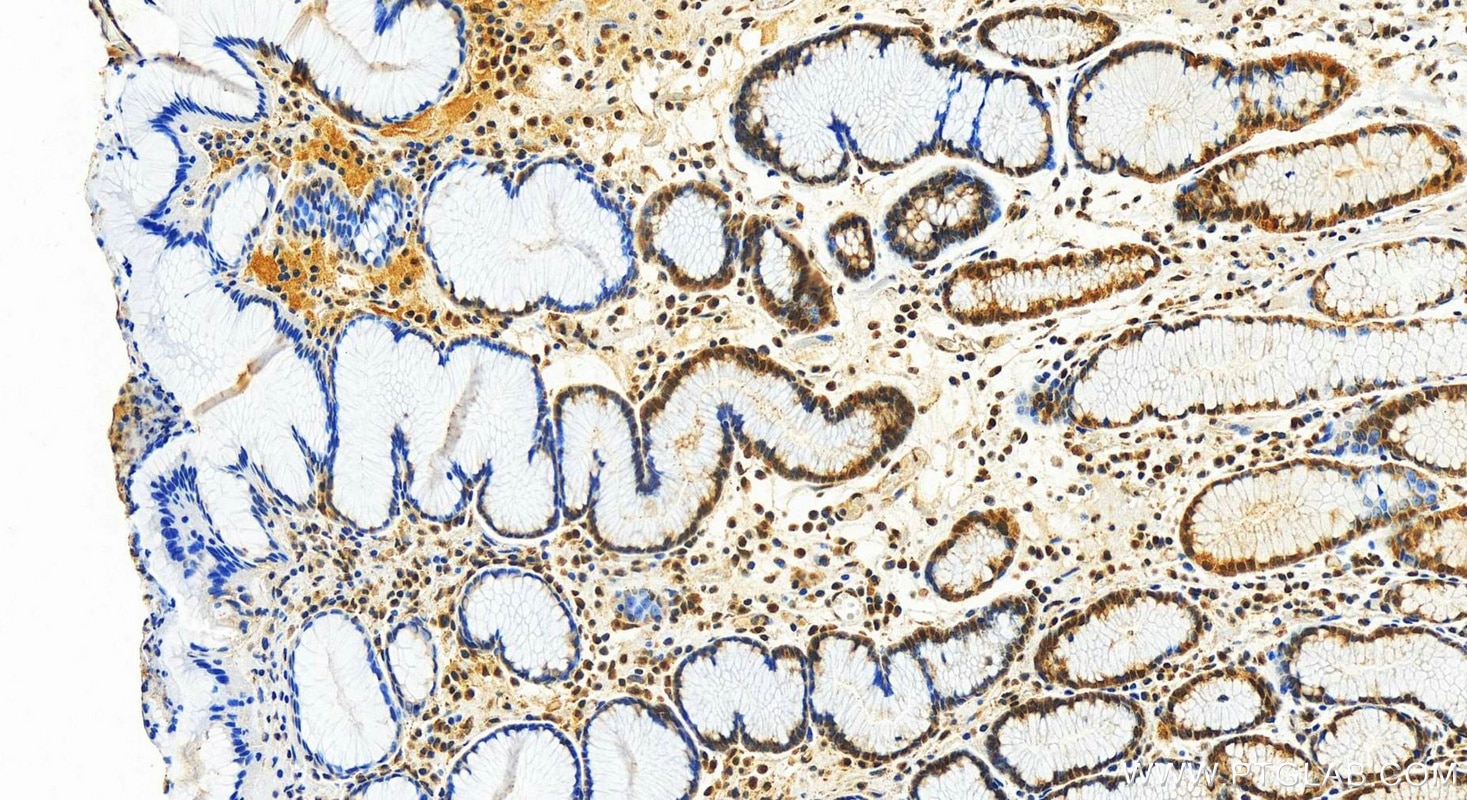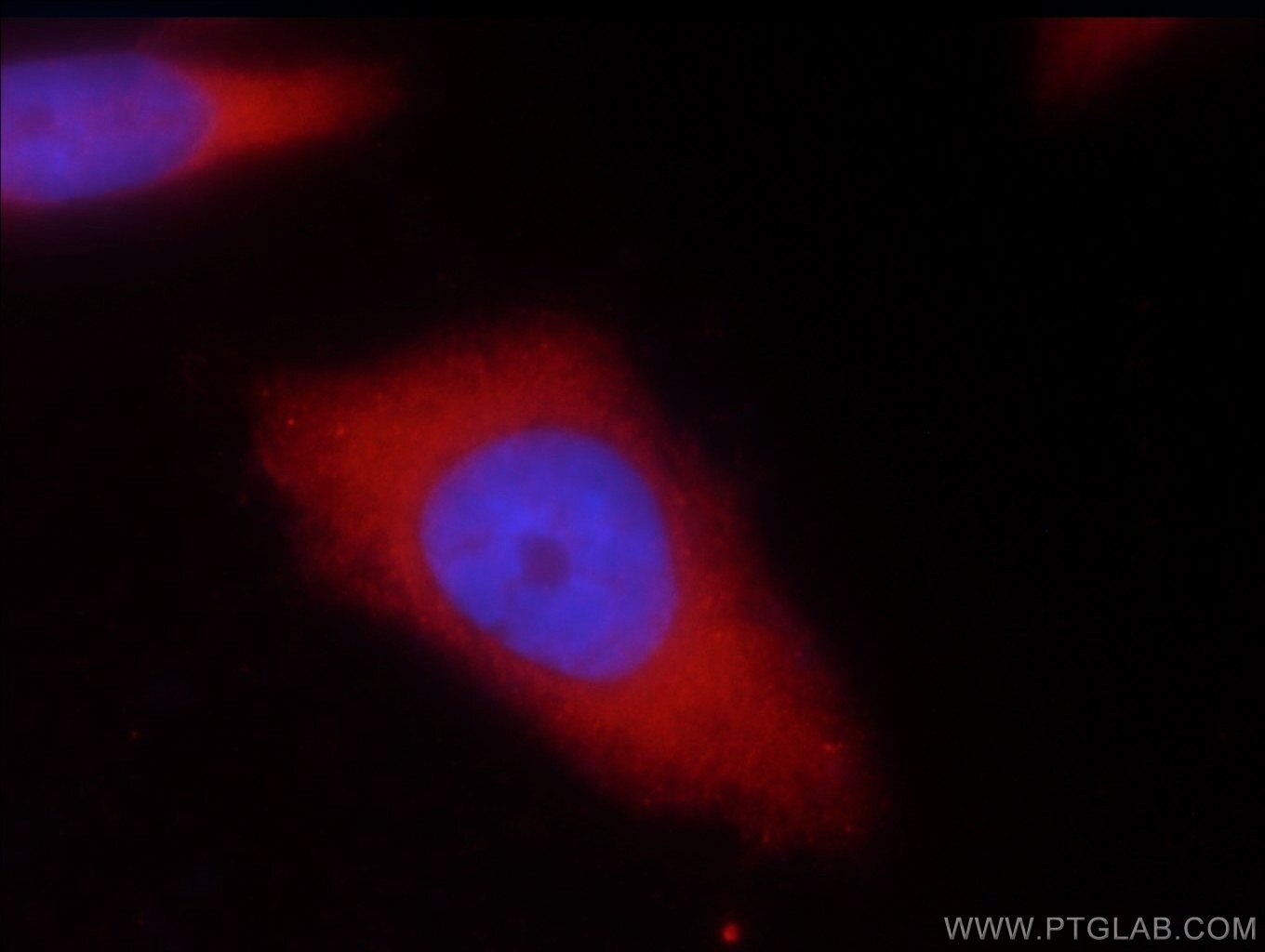- Featured Product
- KD/KO Validated
UBE4B Polyklonaler Antikörper
UBE4B Polyklonal Antikörper für WB, IHC, IF/ICC, IP, ELISA
Wirt / Isotyp
Kaninchen / IgG
Getestete Reaktivität
human, Maus, Ratte
Anwendung
WB, IHC, IF/ICC, IP, ELISA
Konjugation
Unkonjugiert
Kat-Nr. : 18148-1-AP
Synonyme
Geprüfte Anwendungen
| Erfolgreiche Detektion in WB | HEK-293T-Zellen, HeLa-Zellen, K-562-Zellen, Maushodengewebe, Raji-Zellen |
| Erfolgreiche IP | HeLa-Zellen |
| Erfolgreiche Detektion in IHC | humanes Magenkrebsgewebe Hinweis: Antigendemaskierung mit TE-Puffer pH 9,0 empfohlen. (*) Wahlweise kann die Antigendemaskierung auch mit Citratpuffer pH 6,0 erfolgen. |
| Erfolgreiche Detektion in IF/ICC | HeLa-Zellen |
Empfohlene Verdünnung
| Anwendung | Verdünnung |
|---|---|
| Western Blot (WB) | WB : 1:2000-1:10000 |
| Immunpräzipitation (IP) | IP : 0.5-4.0 ug for 1.0-3.0 mg of total protein lysate |
| Immunhistochemie (IHC) | IHC : 1:200-1:800 |
| Immunfluoreszenz (IF)/ICC | IF/ICC : 1:10-1:100 |
| It is recommended that this reagent should be titrated in each testing system to obtain optimal results. | |
| Sample-dependent, check data in validation data gallery | |
Veröffentlichte Anwendungen
| KD/KO | See 3 publications below |
| WB | See 8 publications below |
| IHC | See 3 publications below |
| IP | See 1 publications below |
Produktinformation
18148-1-AP bindet in WB, IHC, IF/ICC, IP, ELISA UBE4B und zeigt Reaktivität mit human, Maus, Ratten
| Getestete Reaktivität | human, Maus, Ratte |
| In Publikationen genannte Reaktivität | human |
| Wirt / Isotyp | Kaninchen / IgG |
| Klonalität | Polyklonal |
| Typ | Antikörper |
| Immunogen | UBE4B fusion protein Ag12836 |
| Vollständiger Name | ubiquitination factor E4B (UFD2 homolog, yeast) |
| Berechnetes Molekulargewicht | 1173 aa, 133 kDa |
| Beobachtetes Molekulargewicht | 146 kDa |
| GenBank-Zugangsnummer | BC093696 |
| Gene symbol | UBE4B |
| Gene ID (NCBI) | 10277 |
| Konjugation | Unkonjugiert |
| Form | Liquid |
| Reinigungsmethode | Antigen-Affinitätsreinigung |
| Lagerungspuffer | PBS with 0.02% sodium azide and 50% glycerol |
| Lagerungsbedingungen | Bei -20°C lagern. Nach dem Versand ein Jahr lang stabil Aliquotieren ist bei -20oC Lagerung nicht notwendig. 20ul Größen enthalten 0,1% BSA. |
Hintergrundinformationen
UBE4B (Ubiquitin Conjugation E4 B) is a protein-coding gene that plays a crucial role in the ubiquitination process, which is essential for protein degradation and regulation of various cellular processes. UBE4B functions as both an E3 and E4 ubiquitin ligase. It collaborates with other ubiquitin ligases to catalyze the transfer of ubiquitin molecules to target proteins, leading to their degradation or other intracellular sorting events. For example, UBE4B has been shown to ubiquitinate and degrade proteins such as Ku70, c-FLIPL, and p53. It also interacts with the E3 ubiquitin ligase ITCH to induce polyubiquitination and proteasomal degradation of target proteins.
Protokolle
| PRODUKTSPEZIFISCHE PROTOKOLLE | |
|---|---|
| WB protocol for UBE4B antibody 18148-1-AP | Protokoll herunterladen |
| IHC protocol for UBE4B antibody 18148-1-AP | Protokoll herunterladenl |
| IF protocol for UBE4B antibody 18148-1-AP | Protokoll herunterladen |
| IP protocol for UBE4B antibody 18148-1-AP | Protokoll herunterladen |
| STANDARD-PROTOKOLLE | |
|---|---|
| Klicken Sie hier, um unsere Standardprotokolle anzuzeigen |
Publikationen
| Species | Application | Title |
|---|---|---|
Mol Cell RNF126-Mediated Reubiquitination Is Required for Proteasomal Degradation of p97-Extracted Membrane Proteins. | ||
Mol Carcinog Expression and prognostic role of ubiquitination factor E4B in primary hepatocellular carcinoma. | ||
Proteomics SILAC-based Quantitative Proteomic Analysis of Secretome between Activated and Reverted Hepatic Stellate Cells. | ||
Onco Targets Ther The Roles of Ubiquitination Factor E4B (UBE4B) in the Postoperative Prognosis of Patients with Renal Cell Carcinoma and in Renal Tumor Cells Growth and Metastasis.
| ||
Pathol Res Pract UBE4B promotes the development of lung adenocarcinoma by enhancing proliferation, migration and glycolysis via PP2A/AKT signaling. | ||
Biochim Biophys Acta Gene Regul Mech UBE4A catalyzes NRF1 ubiquitination and facilitates DDI2-mediated NRF1 cleavage
|
